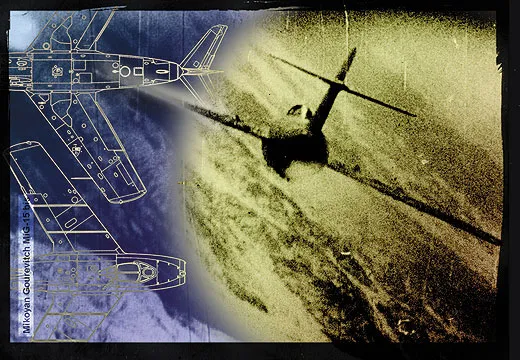The Original Men in Black?
UFO investigations may have been the least exciting duty for the Air Intelligence Service Squadron.
/https://tf-cmsv2-smithsonianmag-media.s3.amazonaws.com/filer/oldies-oddities-aug-2012-1_FLASH.jpg)
During World War II, collecting intelligence on opposing air forces was mostly a matter of recovering downed aircraft, capturing enemy airmen, and flying reconnaissance missions. But in the early years of the cold war, when the Soviets hung the Iron Curtain, none of those methods was practical. Noting that “certain information will never be obtained until the enemy exposes its military potential to us in the form of an attack,” the U.S. Air Force established the Air Intelligence Service Squadron.
The first AISS, the 7001st, was formed in November 1948 in Europe and comprised mostly linguists who served as translators and interrogators for the collection of intelligence from ex-enemy officers, civilians, and officials from occupied countries. The linguists gathered information unavailable during the war and on areas behind the Iron Curtain.
In South Korea, the 6004th AISS recovered material abandoned by North Korea, including a T-34 tank and pieces of downed MiG-15 fighters. Some missions ventured into North Korea on top secret operations. Later AISS units, set to spring into action once the supposedly inevitable Soviet attack commenced, were charged with rounding up Soviet airmen who had parachuted from downed bombers, locating and analyzing the wreckage of their aircraft, and pumping the fliers for information.
While the Air Force waited for the thunder of Soviet bombers, the 5004th AISS, activated in 1951 in Alaska, operated virtually on the shores of the Soviet Union, collecting Soviet aircraft and ship debris and wreckage that washed ashore. Dubbed Beachcomber, the operation deployed Air Force personnel working with Inuit natives (who acted as guides and transported Air Force personnel along the beaches in boats with driftwood frames covered in seal skin). In just two months in the summer of 1953, 5004th personnel combing the beaches of St. Lawrence Island and the Seward Peninsula recovered 115 bits of Soviet junk. While the primary goal was pieces of wrecked ships or aircraft, searchers also picked up discarded or lost items—anything, no matter how trivial, that might provide a glimpse into the Soviet way of life. The unit also conducted electronic intelligence, photographed Soviet aircraft and ships, and maintained caches of survival gear for American personnel in the Arctic.
Some finds shed light on earlier foes: In 1955, the 5004th recovered the remains of a World War II Japanese Fu-Go balloon, complete with bomb, meant to attack the United States.
Perhaps the most famous AISS unit (relatively speaking, for a secret organization) was the 4602nd. With 19 detachments spread across the United States, the 4602nd was, like other AISS units, officially responsible for “rapid exploitation and field analysis of downed enemy aircraft and uniformed personnel.” But the unit was soon tapped to investigate reports of unidentified flying objects in conjunction with Project Blue Book, the Air Force’s UFO inquiry. Some buffs insist that the legendary “Men in Black” figures who supposedly harassed UFO witnesses were from the 4602nd.
Every AISS member was trained in interrogation and counterintelligence, all-weather survival techniques, and at least one technical specialty, with an emphasis on multiple skills and cross-training. In accordance with their chief job, dealing with renegade Soviet airmen, most AISSers were fluent in Russian and other Slavic languages, along with Russian history and culture. Because they had to be able to get anywhere in their assigned area within six hours—including places largely inaccessible by conventional transportation—most were graduates of the Army paratrooper school at Fort Benning, Georgia. If a secret Air Force airplane crashed, or an aircraft went down carrying classified cargo, it was usually up to the AISS to parachute in, secure the scene, and keep away nosy civilians.
By the late 1950s, Air Intelligence Service Squadrons were officially disbanded, although, in typical military practice, that means they were simply reorganized under new names.
